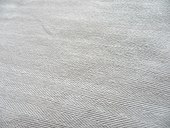Coutil
Coutil (or Coutille) is a twill-woven cloth used to make table covers, mattresses and tents, as well as corsets, orthotic supports, and other types of durable garments.[1]
Description

Coutil is a sturdy, tightly-woven fabric used in a wide variety of clothing and household goods. Like other fabrics in the twill family, it is noted for its strength, durability, and ability to hide dirt.[2]
There is some overlap between coutil and other twill weaves, such as drill, jean, and ticking. Historically these terms could be used somewhat interchangeably, for example, the use of “French jean”[1] to denote coutil used in corsetry.
In the past, coutil was made in a wide variety of weights and fibers including cotton, hemp, linen, and wool. Heavier versions made of linen or hemp were used to make clothing for work, hunting or sports.[3] Tightly-woven, 100% cotton coutil with or without stripes is used to make mattresses. A variation featuring a herringbone weave is commonly used in corsets and ballet bodices.[4]
New technology uses petroleum residues from recycled plastic bottles mixed with cotton to create a high-tech fiber used in the production of coutil and other fabrics. [5]
History
The names for coutil have shifted over time, along with trends in usage and popularity. For example, a type of coutil with brightly-colored stripes has been produced in the Basque region that sits across France and Spain for over 100 years. This textile was originally named Béarnese coutil (coutil béarnais) and was used to protect livestock from the elements. By the 1920s, it had become a popular material for tablecloths, and the name was updated to linge basque (not to be confused with a Basque) in order to appeal to the Parisian market. [6] These changes helped smaller textile manufacturers remain in business for generations. One such example is a family business in Orthez, France which started as a coutil pants (coutil-pantalon) shop before transitioning into table linens in the 1920s. [7]
Corset coutil has been produced in Europe since the 1800’s, with English and German coutil having a reputation for high quality. This industry was supported by large corset manufacturers who used locally-produced materials, such as Axford’s Corsets, who closed in 2019.[8] Corset makers report that many of the European fabric mills that manufactured coutil have also closed, with new supplies coming from India and China.[9]
Use in Corsetry

Corset coutil is traditionally woven in a herringbone or broken twill pattern. Satin-faced, brocade, and broche (or broché) versions are also available.
Coutil became a popular choice for corsets as early as the 1820’s, though it may have been used earlier under other names, such as jean.[10][11] The fabric's physical properties make it a popular choice among corsetmakers.[9] As well as having strength and durability,100% cotton coutil wicks moisture away from the body and has good dimensional stability, which means it will not stretch even when laced tightly.[12] In addition, the herringbone weave of corset coutil alternates stripes of left hand twill and right hand twill, reducing the possibility of the fabric skewing along the diagonal of the twill pattern, which can be an issue with basic twill weaves.[13]
See also
References
- ^ a b Harmuth, Louis (1915). Dictionary of textiles. University of California Libraries. New York, Fairchild publishing company.
- ^ Kiron, Mazharul Islam (June 2, 2015). "Twill Weave: Features, Classification, Derivatives and Uses". Textile Learner. Retrieved February 22, 2025.
- ^ "Chasse au marais - Fusils Robert. Veste de coutil, pantalon en coutil de laine, guêtres espagnoles - tressées, chapeau de paille. Veste de velours, pantalons de coutil, chapeau de feutre". www.digitalcommonwealth.org. Retrieved February 22, 2025.
- ^ "Inside Look: The Sleeping Beauty's Nymph Costumes". Boston Ballet. Retrieved February 23, 2025.
- ^ "Colombie: les tissus recyclés, nouvelles stars du salon du textile de Medellín". www.20minutes.fr (in French). February 4, 2011. Retrieved September 16, 2020.
- ^ "Vers une IGP pour le linge basque". La République des Pyrénées (in French). May 28, 2020. Retrieved September 16, 2020.
- ^ "A Orthez, l'entreprise familiale de tissage s'apprête à fêter ses 100 ans. Elle veut continuer à privilégier l'innovation et à valoriser les circuits-courts…". PresseLib (in French). January 17, 2019. Retrieved September 16, 2020.
- ^ "Axfords Corsets: A Family Business". Great British Life. November 8, 2011. Retrieved February 23, 2025.
- ^ a b "What is Coutil?". www.sewcurvy.com. March 8, 2014. Archived from the original on September 26, 2020. Retrieved September 16, 2020.
- ^ Burtel, Madame Auteur du texte (1826). Art de faire les corsets , suivi de l'art de faire les guêtres et les gants, par Mad. Burtel,...
- ^ Mary J. Howell (1847). The hand-book of millinery. To which is appended an essay on corset making. Oxford University.
- ^ Kittinaovarut, Siriwan (September 15, 1998). Polymerization-Crosslinking Fabric Finishing, With Pad-Dry-Cure, Using Nonformaldehyde Btca/IA/AA Combinations to Impart Durable Press Properties in Cotton Fabric (Thesis).
- ^ "Broken Twill". Heddels. Retrieved February 23, 2025.
